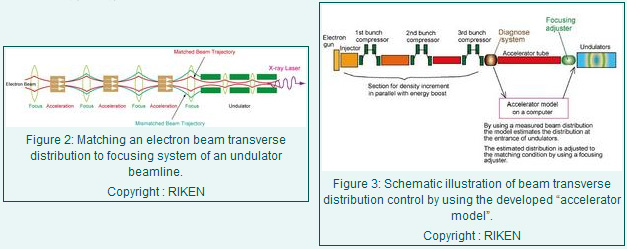Home > Press > Next-generation light source gets boost from powerful new analysis technique
 |
Abstract:
A new analysis technique for the design and optimization of beam optics has successfully been used to model the group behavior of electron beams over a linear accelerator, paving the way for its use at linear accelerator based light source facilities around the world.
Next-generation light source gets boost from powerful new analysis technique
Tokyo | Posted on November 5th, 2010The technique contributes to improved operation of the X-ray Free-Electron Laser (XFEL) under construction at the RIKEN SPring-8 synchrotron radiation facility, whose intense beams will open a unique window onto the minuscule structure of molecules and the rapid reaction of chemical species.
Despite its key importance to all fields of science, the world of atoms and molecules exists beyond the reach of traditional observation techniques, holding back progress in research on everything from molecular biology to nanotechnology.
The new XFEL at RIKEN, Japan's flagship research institute, will shed first-ever light on this hidden world, delivering radiation one billion times brighter and with pulses one thousand times shorter than existing X-ray sources such as SPring-8. The XFEL facility will be only the second laser of its kind in the world when it opens in 2011.
Obtaining a stable XFEL beam, however, is not an easy task. To do so, the transverse distribution of electrons ejected from the XFEL's linear accelerator must be carefully calibrated each time conditions change to match the configuration of magnets (undulators) where X-ray laser radiation is emitted (Fig. 2). In experiments with a small test accelerator, researchers performed this calibration by directly measuring the laser intensity, but the full-sized XFEL is too complicated for this approach to work.
The new technique, developed at RIKEN and the Japan Synchrotron Radiation Research Institute (JASRI), solves this problem by rapidly and precisely computing the effect of changes in optics using information on electron beam distributions after full bunch compression (Fig. 3). By doing so, the technique plays a key role in ensuring the successful operation of the XFEL, whose intense beams promise to herald a new era of scientific exploration and discovery.
Journal information
Toru Hara, Kazuaki Togawa and Hitoshi Tanaka. Transverse envelope analysis for accelerating relativistic electron beams in a linear accelerator as a photon source. Nuclear Instruments and Methods in Physics Research Section A, 17 September 2010. DOI: 10.1016/j.nima.2010.09.035
####
For more information, please click here
Contacts:
Dr. Hitoshi Tanaka
Beam Commissioning Team
XFEL Project Head Office
Tel/Fax: +81-(0)791-58-2862
Ms. Tomoko Ikawa (PI officer)
Global Relations Office
RIKEN
Tel: +81-(0)48-462-1225
Fax: +81-(0)48-463-3687
Copyright © RIKEN
If you have a comment, please Contact us.Issuers of news releases, not 7th Wave, Inc. or Nanotechnology Now, are solely responsible for the accuracy of the content.
| Related News Press |
News and information
![]() Simulating magnetization in a Heisenberg quantum spin chain April 5th, 2024
Simulating magnetization in a Heisenberg quantum spin chain April 5th, 2024
![]() NRL charters Navy’s quantum inertial navigation path to reduce drift April 5th, 2024
NRL charters Navy’s quantum inertial navigation path to reduce drift April 5th, 2024
![]() Discovery points path to flash-like memory for storing qubits: Rice find could hasten development of nonvolatile quantum memory April 5th, 2024
Discovery points path to flash-like memory for storing qubits: Rice find could hasten development of nonvolatile quantum memory April 5th, 2024
Chemistry
![]() What heat can tell us about battery chemistry: using the Peltier effect to study lithium-ion cells March 8th, 2024
What heat can tell us about battery chemistry: using the Peltier effect to study lithium-ion cells March 8th, 2024
![]() Nanoscale CL thermometry with lanthanide-doped heavy-metal oxide in TEM March 8th, 2024
Nanoscale CL thermometry with lanthanide-doped heavy-metal oxide in TEM March 8th, 2024
![]() Focused ion beam technology: A single tool for a wide range of applications January 12th, 2024
Focused ion beam technology: A single tool for a wide range of applications January 12th, 2024
Laboratories
![]() A battery’s hopping ions remember where they’ve been: Seen in atomic detail, the seemingly smooth flow of ions through a battery’s electrolyte is surprisingly complicated February 16th, 2024
A battery’s hopping ions remember where they’ve been: Seen in atomic detail, the seemingly smooth flow of ions through a battery’s electrolyte is surprisingly complicated February 16th, 2024
![]() NRL discovers two-dimensional waveguides February 16th, 2024
NRL discovers two-dimensional waveguides February 16th, 2024
Possible Futures
![]() Discovery points path to flash-like memory for storing qubits: Rice find could hasten development of nonvolatile quantum memory April 5th, 2024
Discovery points path to flash-like memory for storing qubits: Rice find could hasten development of nonvolatile quantum memory April 5th, 2024
![]() With VECSELs towards the quantum internet Fraunhofer: IAF achieves record output power with VECSEL for quantum frequency converters April 5th, 2024
With VECSELs towards the quantum internet Fraunhofer: IAF achieves record output power with VECSEL for quantum frequency converters April 5th, 2024
Announcements
![]() NRL charters Navy’s quantum inertial navigation path to reduce drift April 5th, 2024
NRL charters Navy’s quantum inertial navigation path to reduce drift April 5th, 2024
![]() Discovery points path to flash-like memory for storing qubits: Rice find could hasten development of nonvolatile quantum memory April 5th, 2024
Discovery points path to flash-like memory for storing qubits: Rice find could hasten development of nonvolatile quantum memory April 5th, 2024
|
|
||
|
|
||
| The latest news from around the world, FREE | ||
|
|
||
|
|
||
| Premium Products | ||
|
|
||
|
Only the news you want to read!
Learn More |
||
|
|
||
|
Full-service, expert consulting
Learn More |
||
|
|
||








